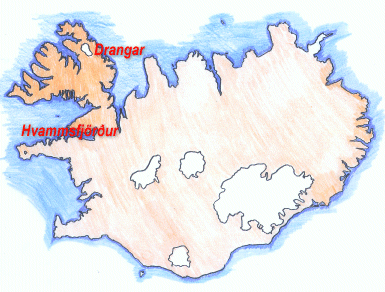See also the lay
of Greenland and a map of Greenland
The Icelanders came there in the east coast around the year
985. There were two inhabited districts of nordic people in
Greenland, both of them located on the west coast and they were called
the
Western and the Eastern settlement . According
to old sources the farms were about 90 in the Western settlement
which was divided in 4 parishes. About 190 farms were in the
Eastern settlement which was divided in 12 parishes. From this
information it's concluded that the inhabitants must have been about
3-4000 at most. Modern research have showed old
ruins of over 200 farms in the Eastern settlement and about 80 in
the Western settlement.
Written sources tell that Eiríkur
rauði had came to Iceland with his father, Thorvaldur. They
fled from Norway. When they came to Iceland the settlement
was almost over and they had to make do with a a piece of rather
isolated land, Drangar,
near Drangjökull (The Drangar-glacier) . Eirikur got married into
a rather well-off family, his wife was Tjodhildur Jorundardottir
from Haukadalur. And he
moved there after the death of his father.

[You can get a more detailed map if you press Hvammsfjörður
and also get further information by pressing Drangar. Þórunn
drew
the map of Iceland.]
Eirikur soon got into some trouble and was deemed an outlaw from
Haukadalur. So he moved westwards and settled in Oxney
(a small island) in the outlet of Hvammsfjordur. Again Eirikur
got into trouble and this time, at the Thorsnescongress, he
was sentenced to exile from Iceland for 3 years.
This took place in 982. He searched for a land in west, Gunnbjarnasker,
which Gunnbjorn, the son of Ulf kraka, claimed to have
seen when when he drifted in the west ocean some years before. Eirikur
stayed there for the 3 years of his exile.
 Then
he went back home to Iceland and found some allies for colonization. He
wanted to call the new land Greenland because he thought that people
would like to go there if the land had an attractive name.
25 ships and about 5-700 people from Borgarfjordur and Breidarfjordur,
joined Eirikur in his journey. The journey did not go very well and only
14 ships made it to the shore og Greenland.
Then
he went back home to Iceland and found some allies for colonization. He
wanted to call the new land Greenland because he thought that people
would like to go there if the land had an attractive name.
25 ships and about 5-700 people from Borgarfjordur and Breidarfjordur,
joined Eirikur in his journey. The journey did not go very well and only
14 ships made it to the shore og Greenland.
As in Iceland the settlement in Greenland was organized by some
great chieftains. Those few chieftains divided the land between themselves
and then their families and allies were permitted to build on there
land. The society that developed in Greenland was a lot
like the Icelandic society at this time. The settlers established their
own parlament; took up Christian faith, built churches and established
a diocese. Brattahlid was
the capital place of Greenland in the times of Eirikur raudi and
was for a long time residence of chieftains. Parlament was held in
the first years of the settlement of Greenland. Eirkur raudi
did not like the Christian faith and he cursed this religion till
the end of his life.
What happened to the nordic population of Greenland?
There are many theories concerning the vanishing of the nordic people
from Greenland. For example: That the Norse had died of hunger;
that they had degenerated; that they had fought with the Inuits
an lost; that some English pirates had come to Greenland and terminated
all the Norse people; that some plague had raged and everybody
died etc.
On a conference of scholars, held in Santa Cruiz in the Canariesa few
years ago, a new theory of the vanishing of Norse people in
Greenland was stated. The theory is like this: Some Portugese ships came
to Greenland in the years 1470 and 1477. The sailors allured the
Norse people on board, kidnapped them and then sold them on a slavemarket
in Tenerife. Some sources like local names in Tenerife seem to support
this theory. But still this is doubtful because no histories of these nordic
people have survived in the oral tradition of Tenerife.
No theories concerning what became of the Nordic population have been
prooved to be true. The vanishing of the Norse people will probably
remain a one big mystery!

